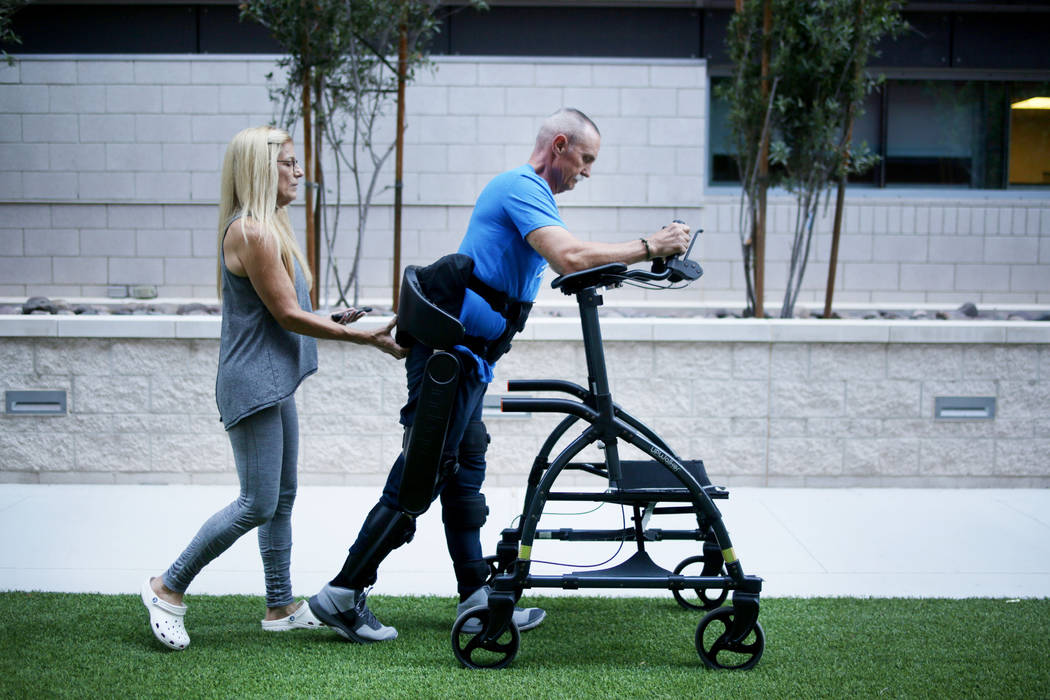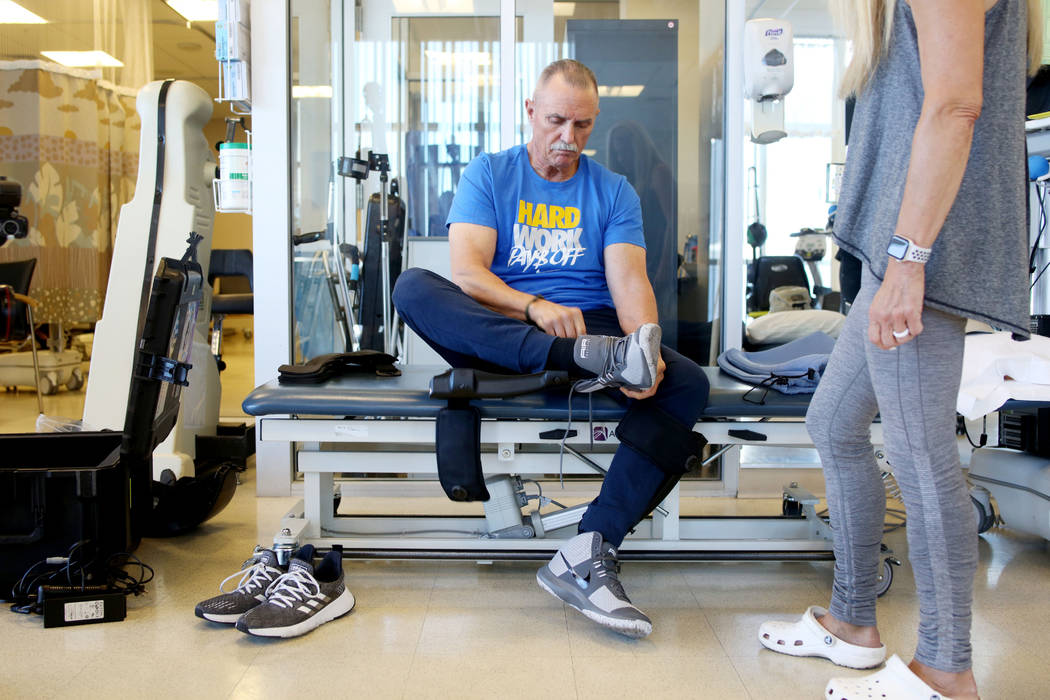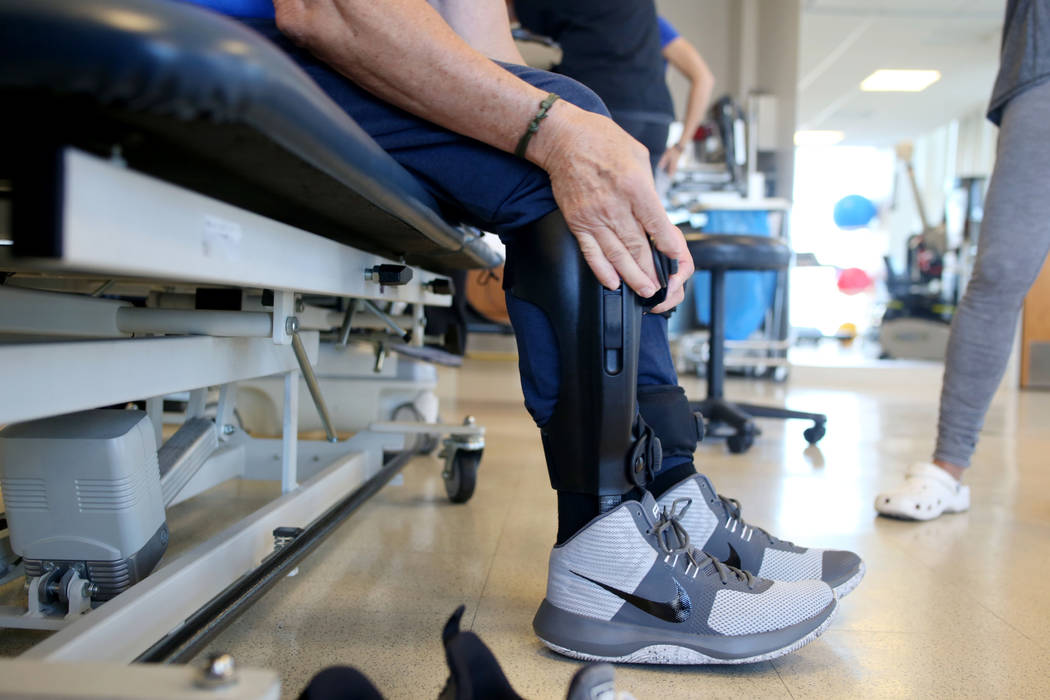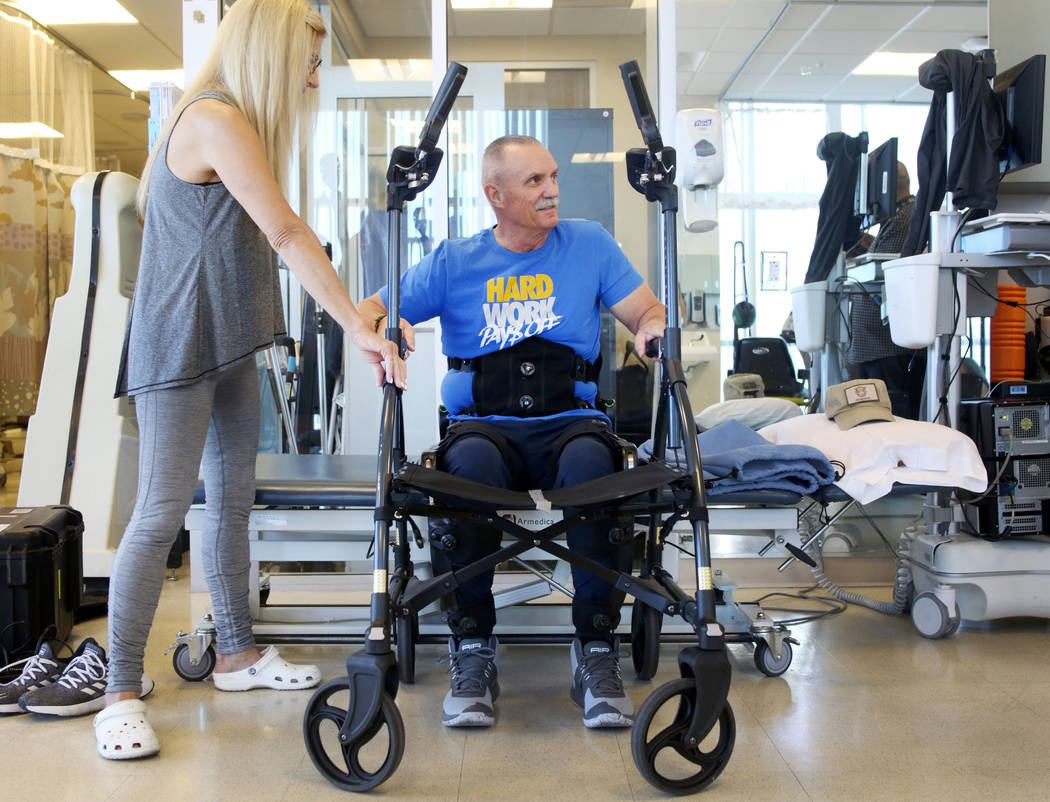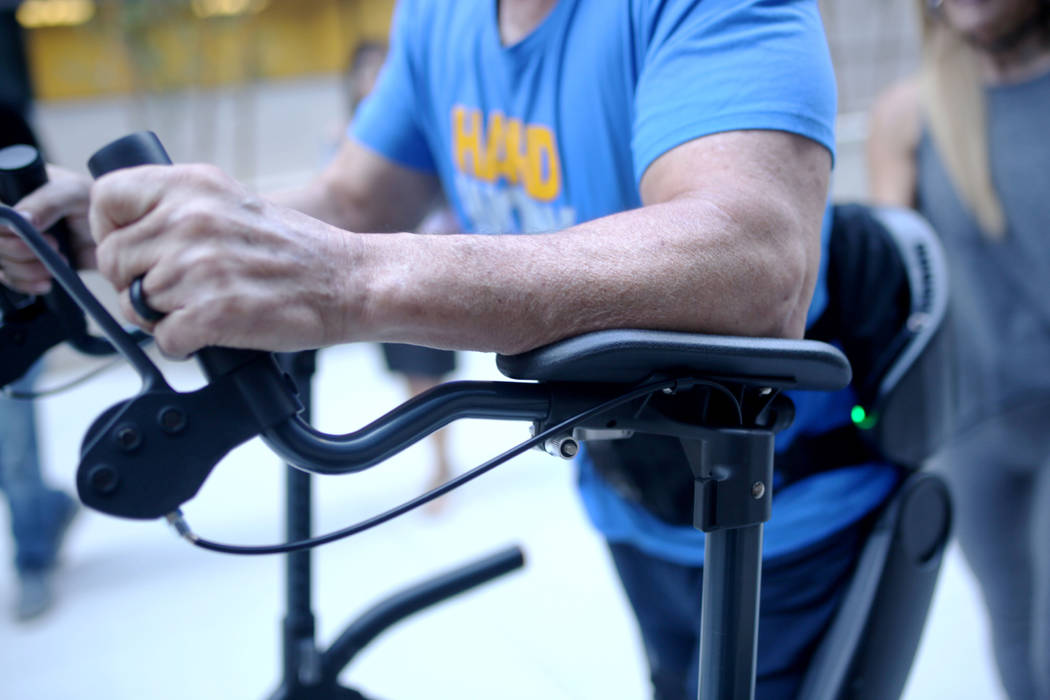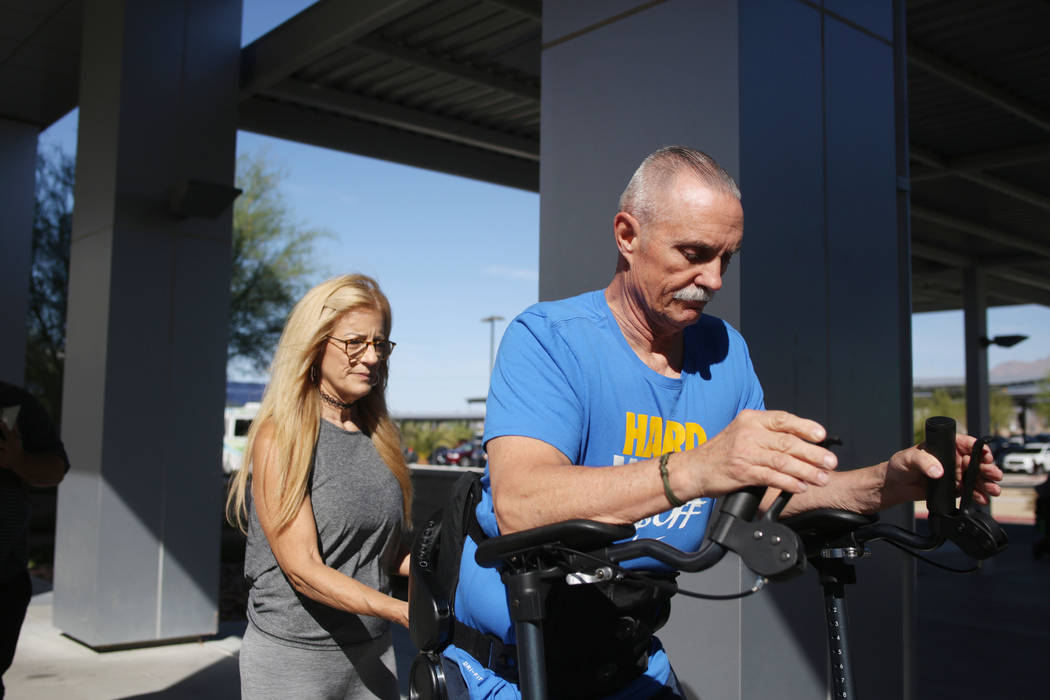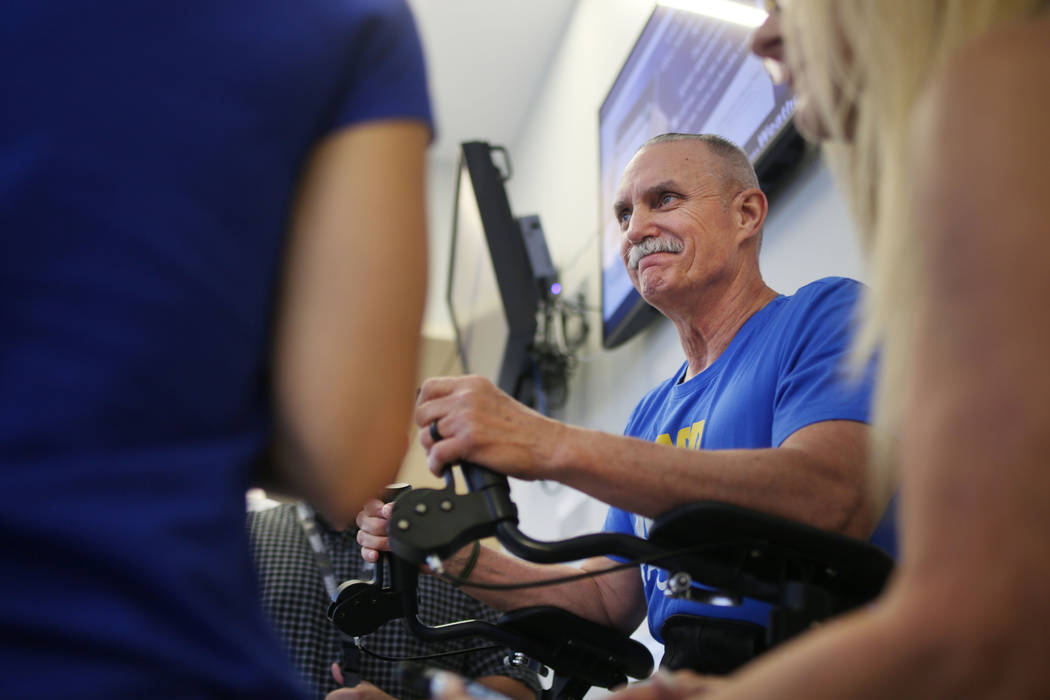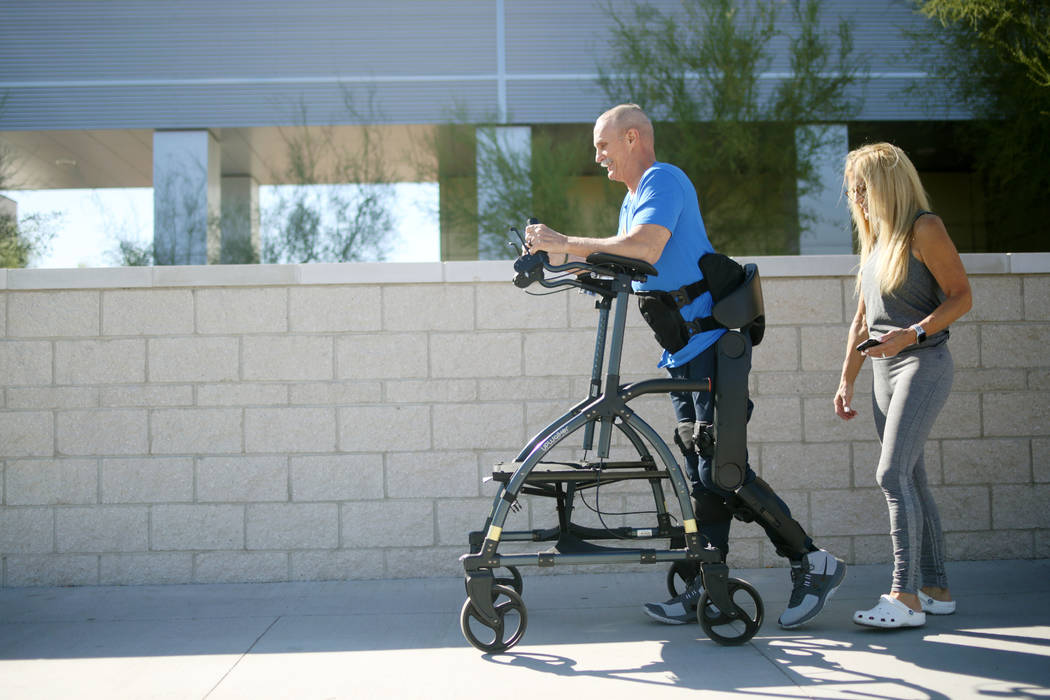Las Vegas veteran walks again thanks to revolutionary ‘exoskeleton’
Just being able to take a stroll with his wife through their Las Vegas neighborhood is a miracle for Mark Christianson.
Christianson, 67, a former Green Beret, was forced to use a wheelchair after being left partially paralyzed by a surgery to remove a tumor on his spinal cord in November 2016.
But in recent weeks, he has been up and about again thanks to a high-tech “exoskeleton” that he recently received through the Department of Veterans Affairs. It’s not quite like the suit in “Iron Man,” but the five-piece device — which consists of a component that wraps around his waist and smaller pieces that assist his muscles — helps him walk by supporting part of his weight and helping him move his legs.
It’s customizable, so he can set it to provide more or less support depending on the terrain, and it is stimulated by postural cues. So when he leans forward, the device knows he wants to walk and automatically triggers the muscle-assistance pieces to help him stride forward.
It also has an artificial intelligence component that can detect if he is beginning to lose his balance and can attempt to quickly correct the situation.
The chargeable, portable device weighs 26 pounds, costs $98,000 and is fully covered by the VA for qualifying spinal cord injury patients, such as Christianson, who lost most of the movement in his legs after his surgery. The device also can help paraplegics with severed spinal cords to walk again.
Christianson, a military man with short, cropped gray hair, neatly trimmed mustache and a stoic demeanor, trained on the device at the VA Southern Nevada Healthcare System hospital in North Las Vegas three times a week over five weeks before taking the device home last month. Two more veterans with spinal cord injuries are expected to start training in the next few months, hospital officials said.
‘Like being a new driver’
Christianson said piloting the exoskeleton has been a learning experience.
“It’s like being a new driver, once you get your driver’s license and you get out on a busy freeway,” he said of the Indego Therapy device manufactured by the Cleveland-based Parker Hannifin Corp. “I still don’t know what I’m going to bump into or who’s going to bump into me.”
Christianson is the first veteran in Southern Nevada to receive one of the devices through the VA, and he said an Indego Therapy representative told him he is just the eighth U.S. military veteran in the nation to get one.
The retired sergeant 1st class in the U.S. Army Special Forces received his initial training on the exoskeleton at the VA medical center in Palo Alto, California, but was able to complete the work at the local hospital after a deal was reached this summer to push the training out to other VA facilities treating spinal cord injuries.
He demonstrated his growing ability to pilot the rig recently at the North Las Vegas facility.
To strap into the contraption, Christianson laced himself into a pair of Nike high-tops, twisted tight the sides of the pieces that secured his knees and scooted into the backpiece, which contains a small lithium battery that can go up to four hours between charges.
Christianson then used his arms to push himself up and grip onto the controls of a walker that helps him maintain his balance.
“I don’t bunny hop,” he assured his physical therapists, who laughed. The machine flashed green, indicating it was ready to go.
Christianson then used his upper torso to cue the device into action.
As he went to take his first step, a tiny motor whirred to life and helped him will his leg forward on a hospital walkway
“Your riding crop, sir,” said his wife, Lisa, as she helped him wheel the walker.
Purple Heart recipient
Christianson, a Purple Heart recipient, also has another injury stemming from the war: He had been shot in the back of his feet.
“On top of everything, he’s walking on fixed feet,” Lisa Christianson said.
But it was the spinal cord injury that changed the former soldier’s life dramatically. He could stand for short periods with assistance but needed a wheelchair to go out. He couldn’t go fishing, throw footballs and play with his grandkids or take a hike with his wife.
In the immediate aftermath of the surgery, he couldn’t even sit up by himself.
“It was like taking care of a 170-pound baby after (the) surgery,” his wife said. “This is nothing short of a miracle, and now he can get back to functions we all take for granted.”
Mark Christianson refers to exoskeleton training as a new form of boot camp. His physical therapists credit his military discipline and determination for his success.
“I told him to do 20 reps of something, (and) he would do 23,” said Richard Gastillo, Christianson’s physical therapist at the VA in Palo Alto. “He’s a Special Forces guy. They just set the bar higher.”
Gastillo, who recommended Christianson for the exoskeleton, said the patient was a natural.
“He really picked up on the machine, and it really isn’t the most natural feeling,” he said. “He kind of blew past that, even on his first time in it.”
While working on his own recovery, Gastillo said Christianson tried to motivate other patients.
He recalled a time when Christianson noticed another veteran who was struggling to come to terms with his spinal cord injury.
“Excuse me, son, what’s your name?” he quoted Christianson as saying. “If you witnessed anyone in your platoon doing what you’re doing now, would you be happy with them?”
The next day, Gastillo said, the man came back to the hospital freshly shaved and inspired to work hard.
Final exam
After getting approved for the program, fitted for the device and getting his initial run-through in Palo Alto, Christianson was able to complete his training at the VA hospital in North Las Vegas.
On the last day before being allowed to take the device home, his physical therapist assistant, Roland Robbins, and a representative of Indego Therapy watched Christianson put the device through its paces.
One of the tests was to mimic a stumble to ensure that user and machine were able to cope. Christianson held one foot back as though he had taken a bad step. The machine immediately blinked blue, anticipated the fall and vibrated, buckling Christianson’s knees to allow him a chance to brace himself for the fall.
“Stand tall, babe,” Lisa Christianson encouraged her husband as she whisked strands of long blond hair out of her eyes.
After successfully remaining upright, Christianson stepped outside and onto a grass area before powering across it with ease. Then he and the device tackled a wooden ramp. With each buzz, he pushed his arms forward, using the walker as a crutch.
Going up was harder. He could have increased the amount of work the machine would do, but he chose not to. The machine was supplying 40 percent of the power, Christianson putting forth 60 percent.
But on another, more difficult ramp, his wife increased the power through an app on her iPhone, so the machine would lift his knees up higher and take some of the pressure off his legs.
Many veterans along his path watched in awe. One veteran on a black electric scooter who was waiting for a bus offered encouragement as Christianson headed for the ramp.
‘Don’t try to rush!’
“You’ll make it. Take your time. Don’t try to rush!” he said.
The first couple of weeks with the device at home have been trying, Christianson and his wife said this week.
Getting up his driveway proved to be easier than anticipated, but maneuvering the walker around corners and in tight areas of the house like the laundry room and kitchen has proved difficult.
And on a recent windy Saturday, a gust blew so hard that the machine registered a backward fall and pushed Christianson with considerable force into the trailing wheelchair his wife was pushing. The chair is a necessity, as Christianson can only manage about 50 minutes at a time in the exoskeleton.
He and his wife, who have been married for 22 years, plan to take the suit to Florida in November for an Army buddy’s wedding. In the meantime, Christianson said he has learned to take his time and not force the system.
They will be trying it out at the mall this weekend.
“It’s not the bionic man,” he said, “but it is a means to an end.”
Contact Briana Erickson at berickson@reviewjournal.com or 702-387-5244. Follow @ByBrianaE on Twitter.



